Australian Capital Gain Tax: Tax Residency, CGT Exemption and Relevant Case Laws
VerifiedAdded on 2023/06/10
|11
|4144
|369
AI Summary
This article discusses the tax residency of James, CGT exemption under Division 855 for foreign tax residents, and relevant case laws pertaining to valuation under s. 855-30. It concludes that James is a foreign tax resident and exemption would not be available under Division 855, and hence James would have to pay CGT.
Contribute Materials
Your contribution can guide someone’s learning journey. Share your
documents today.
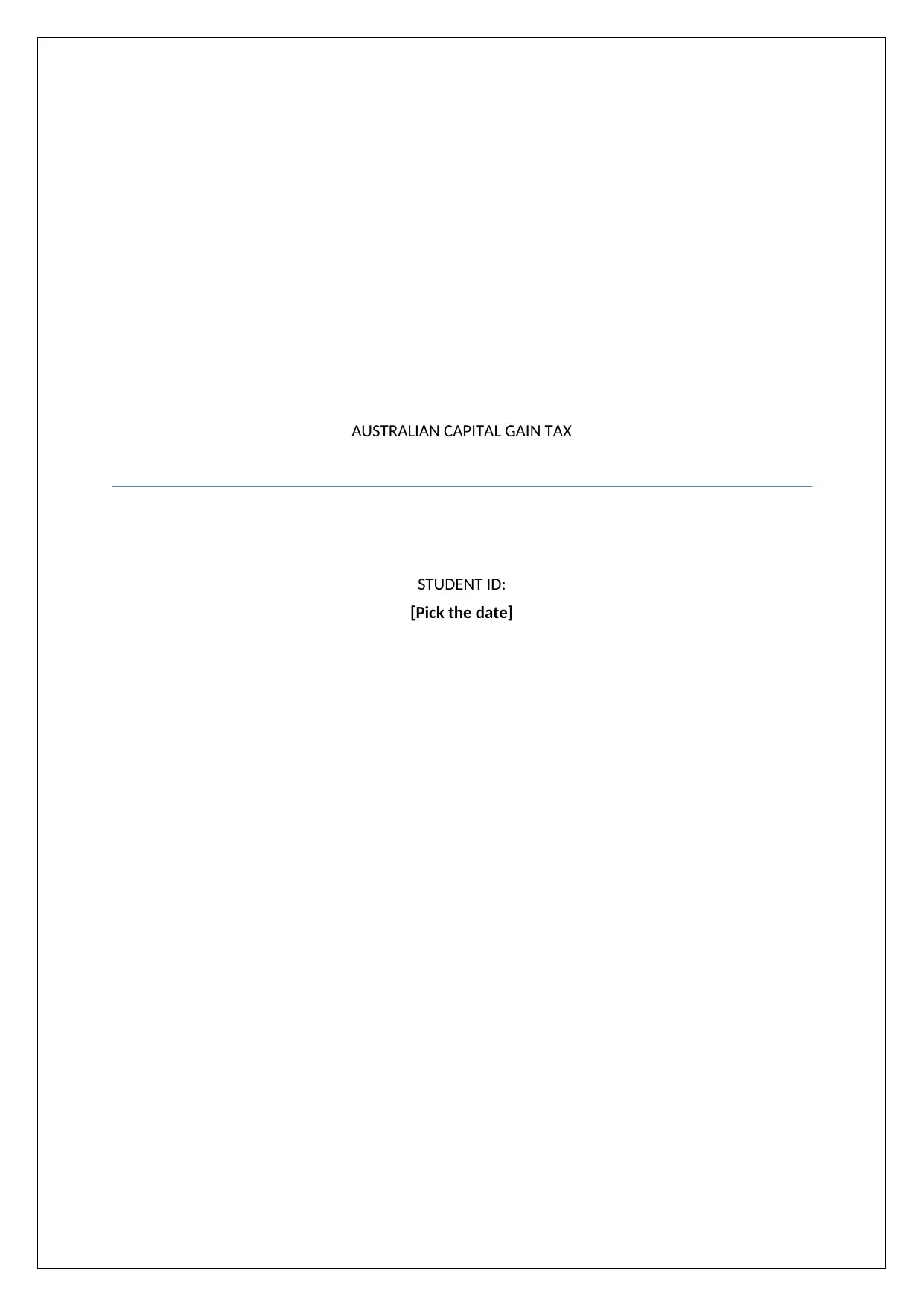
AUSTRALIAN CAPITAL GAIN TAX
STUDENT ID:
[Pick the date]
STUDENT ID:
[Pick the date]
Secure Best Marks with AI Grader
Need help grading? Try our AI Grader for instant feedback on your assignments.
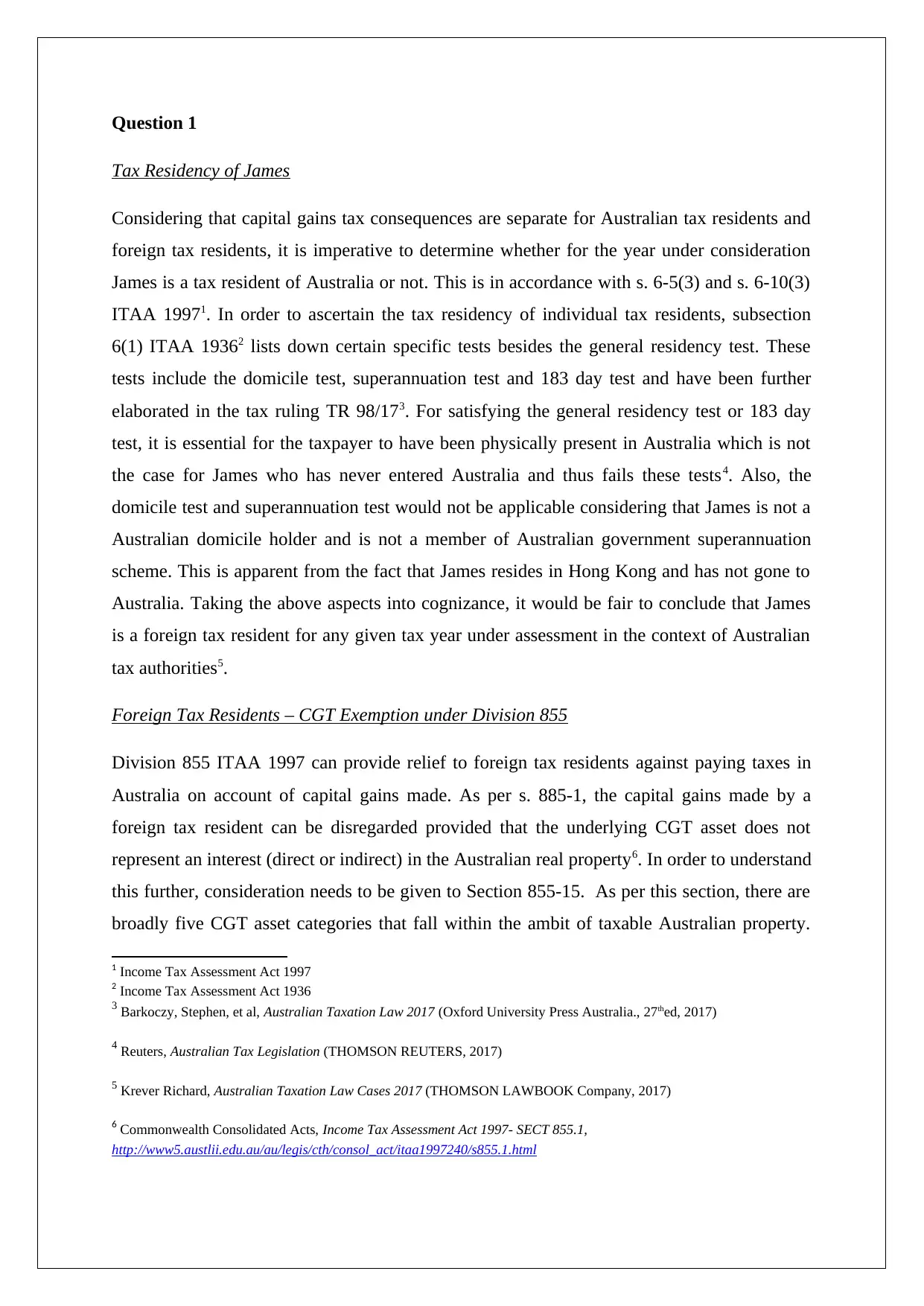
Question 1
Tax Residency of James
Considering that capital gains tax consequences are separate for Australian tax residents and
foreign tax residents, it is imperative to determine whether for the year under consideration
James is a tax resident of Australia or not. This is in accordance with s. 6-5(3) and s. 6-10(3)
ITAA 19971. In order to ascertain the tax residency of individual tax residents, subsection
6(1) ITAA 19362 lists down certain specific tests besides the general residency test. These
tests include the domicile test, superannuation test and 183 day test and have been further
elaborated in the tax ruling TR 98/173. For satisfying the general residency test or 183 day
test, it is essential for the taxpayer to have been physically present in Australia which is not
the case for James who has never entered Australia and thus fails these tests4. Also, the
domicile test and superannuation test would not be applicable considering that James is not a
Australian domicile holder and is not a member of Australian government superannuation
scheme. This is apparent from the fact that James resides in Hong Kong and has not gone to
Australia. Taking the above aspects into cognizance, it would be fair to conclude that James
is a foreign tax resident for any given tax year under assessment in the context of Australian
tax authorities5.
Foreign Tax Residents – CGT Exemption under Division 855
Division 855 ITAA 1997 can provide relief to foreign tax residents against paying taxes in
Australia on account of capital gains made. As per s. 885-1, the capital gains made by a
foreign tax resident can be disregarded provided that the underlying CGT asset does not
represent an interest (direct or indirect) in the Australian real property6. In order to understand
this further, consideration needs to be given to Section 855-15. As per this section, there are
broadly five CGT asset categories that fall within the ambit of taxable Australian property.
1 Income Tax Assessment Act 1997
2 Income Tax Assessment Act 1936
3 Barkoczy, Stephen, et al, Australian Taxation Law 2017 (Oxford University Press Australia., 27thed, 2017)
4 Reuters, Australian Tax Legislation (THOMSON REUTERS, 2017)
5 Krever Richard, Australian Taxation Law Cases 2017 (THOMSON LAWBOOK Company, 2017)
6 Commonwealth Consolidated Acts, Income Tax Assessment Act 1997- SECT 855.1,
http://www5.austlii.edu.au/au/legis/cth/consol_act/itaa1997240/s855.1.html
Tax Residency of James
Considering that capital gains tax consequences are separate for Australian tax residents and
foreign tax residents, it is imperative to determine whether for the year under consideration
James is a tax resident of Australia or not. This is in accordance with s. 6-5(3) and s. 6-10(3)
ITAA 19971. In order to ascertain the tax residency of individual tax residents, subsection
6(1) ITAA 19362 lists down certain specific tests besides the general residency test. These
tests include the domicile test, superannuation test and 183 day test and have been further
elaborated in the tax ruling TR 98/173. For satisfying the general residency test or 183 day
test, it is essential for the taxpayer to have been physically present in Australia which is not
the case for James who has never entered Australia and thus fails these tests4. Also, the
domicile test and superannuation test would not be applicable considering that James is not a
Australian domicile holder and is not a member of Australian government superannuation
scheme. This is apparent from the fact that James resides in Hong Kong and has not gone to
Australia. Taking the above aspects into cognizance, it would be fair to conclude that James
is a foreign tax resident for any given tax year under assessment in the context of Australian
tax authorities5.
Foreign Tax Residents – CGT Exemption under Division 855
Division 855 ITAA 1997 can provide relief to foreign tax residents against paying taxes in
Australia on account of capital gains made. As per s. 885-1, the capital gains made by a
foreign tax resident can be disregarded provided that the underlying CGT asset does not
represent an interest (direct or indirect) in the Australian real property6. In order to understand
this further, consideration needs to be given to Section 855-15. As per this section, there are
broadly five CGT asset categories that fall within the ambit of taxable Australian property.
1 Income Tax Assessment Act 1997
2 Income Tax Assessment Act 1936
3 Barkoczy, Stephen, et al, Australian Taxation Law 2017 (Oxford University Press Australia., 27thed, 2017)
4 Reuters, Australian Tax Legislation (THOMSON REUTERS, 2017)
5 Krever Richard, Australian Taxation Law Cases 2017 (THOMSON LAWBOOK Company, 2017)
6 Commonwealth Consolidated Acts, Income Tax Assessment Act 1997- SECT 855.1,
http://www5.austlii.edu.au/au/legis/cth/consol_act/itaa1997240/s855.1.html
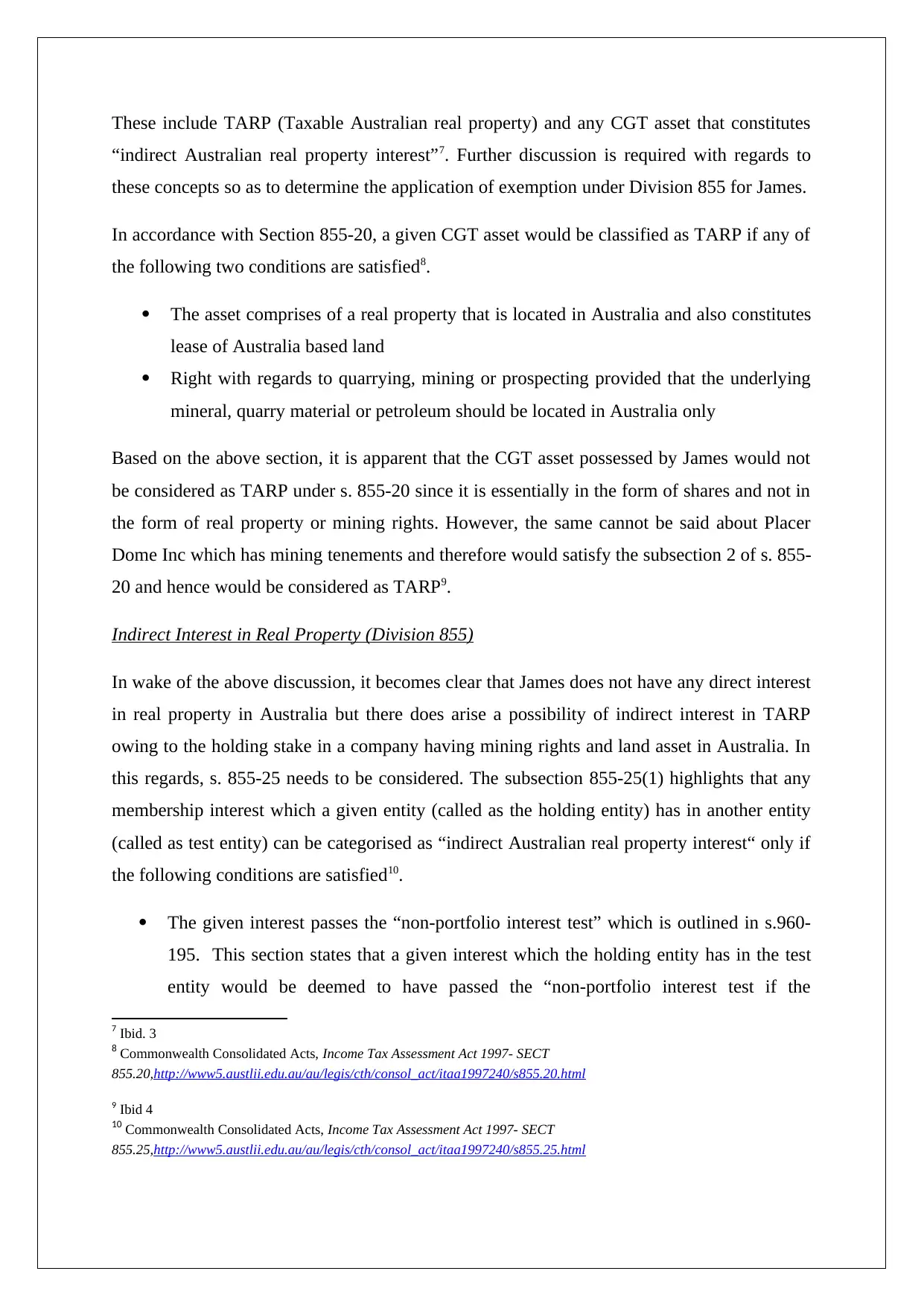
These include TARP (Taxable Australian real property) and any CGT asset that constitutes
“indirect Australian real property interest”7. Further discussion is required with regards to
these concepts so as to determine the application of exemption under Division 855 for James.
In accordance with Section 855-20, a given CGT asset would be classified as TARP if any of
the following two conditions are satisfied8.
The asset comprises of a real property that is located in Australia and also constitutes
lease of Australia based land
Right with regards to quarrying, mining or prospecting provided that the underlying
mineral, quarry material or petroleum should be located in Australia only
Based on the above section, it is apparent that the CGT asset possessed by James would not
be considered as TARP under s. 855-20 since it is essentially in the form of shares and not in
the form of real property or mining rights. However, the same cannot be said about Placer
Dome Inc which has mining tenements and therefore would satisfy the subsection 2 of s. 855-
20 and hence would be considered as TARP9.
Indirect Interest in Real Property (Division 855)
In wake of the above discussion, it becomes clear that James does not have any direct interest
in real property in Australia but there does arise a possibility of indirect interest in TARP
owing to the holding stake in a company having mining rights and land asset in Australia. In
this regards, s. 855-25 needs to be considered. The subsection 855-25(1) highlights that any
membership interest which a given entity (called as the holding entity) has in another entity
(called as test entity) can be categorised as “indirect Australian real property interest“ only if
the following conditions are satisfied10.
The given interest passes the “non-portfolio interest test” which is outlined in s.960-
195. This section states that a given interest which the holding entity has in the test
entity would be deemed to have passed the “non-portfolio interest test if the
7 Ibid. 3
8 Commonwealth Consolidated Acts, Income Tax Assessment Act 1997- SECT
855.20,http://www5.austlii.edu.au/au/legis/cth/consol_act/itaa1997240/s855.20.html
9 Ibid 4
10 Commonwealth Consolidated Acts, Income Tax Assessment Act 1997- SECT
855.25,http://www5.austlii.edu.au/au/legis/cth/consol_act/itaa1997240/s855.25.html
“indirect Australian real property interest”7. Further discussion is required with regards to
these concepts so as to determine the application of exemption under Division 855 for James.
In accordance with Section 855-20, a given CGT asset would be classified as TARP if any of
the following two conditions are satisfied8.
The asset comprises of a real property that is located in Australia and also constitutes
lease of Australia based land
Right with regards to quarrying, mining or prospecting provided that the underlying
mineral, quarry material or petroleum should be located in Australia only
Based on the above section, it is apparent that the CGT asset possessed by James would not
be considered as TARP under s. 855-20 since it is essentially in the form of shares and not in
the form of real property or mining rights. However, the same cannot be said about Placer
Dome Inc which has mining tenements and therefore would satisfy the subsection 2 of s. 855-
20 and hence would be considered as TARP9.
Indirect Interest in Real Property (Division 855)
In wake of the above discussion, it becomes clear that James does not have any direct interest
in real property in Australia but there does arise a possibility of indirect interest in TARP
owing to the holding stake in a company having mining rights and land asset in Australia. In
this regards, s. 855-25 needs to be considered. The subsection 855-25(1) highlights that any
membership interest which a given entity (called as the holding entity) has in another entity
(called as test entity) can be categorised as “indirect Australian real property interest“ only if
the following conditions are satisfied10.
The given interest passes the “non-portfolio interest test” which is outlined in s.960-
195. This section states that a given interest which the holding entity has in the test
entity would be deemed to have passed the “non-portfolio interest test if the
7 Ibid. 3
8 Commonwealth Consolidated Acts, Income Tax Assessment Act 1997- SECT
855.20,http://www5.austlii.edu.au/au/legis/cth/consol_act/itaa1997240/s855.20.html
9 Ibid 4
10 Commonwealth Consolidated Acts, Income Tax Assessment Act 1997- SECT
855.25,http://www5.austlii.edu.au/au/legis/cth/consol_act/itaa1997240/s855.25.html

participation interest (direct and through associate entities) of the holding entity in the
test entity exceeds 10% at the time of conducting the test.
Also, the given interest needs to pass the principal asset test as has been outlined in
s.855-30. As per subsection 855-30(1), the objective of the section is to determine if
mainly the value of the entity is derived from Australian real property or not. Thus,
the principal asset test would be deemed as pass when the market value of the assets
of test entity which fall within the ambit of TARP tends to be higher than the market
value of corresponding assets that do not lie within the ambit of TARP11.
Hence, the above discussion clearly highlights that in order for James to have an indirect
interest in TARP, it is imperative that both the tests outlined in s. 855-25 ought to be
satisfied. Further, it is imperative to note that holding entity is James (a foreign tax resident)
while the test entity is Placer Dome Inc. The non-portfolio interest test is satisfied in the
given case since it is known that James has a 15% stake in the test entity which clearly
exceeds the minimum threshold of 10%. With regards to the principal interest test, it is
noteworthy that for a company in which a foreign tax resident has interest, the satisfaction of
the test requires that the market value of the TARP assets of test entity should clearly exceed
the market value of the non-TARP entity.
Discussion of Relevant Cases –Valuation under s. 855-30
While the above task regarding valuation of TARP and non-TARP assets may seem easy, but
the given case involving Barrick Gold Company and the Commission of State Revenue
clearly highlights the differences in approach adhered to by different parties. The key issue in
this case pertained to the difference regarding the valuation approach which essentially
impacted the stamp duty to be paid. The company advocated that as per the ordinary
valuation principles, the value of the land held by Placer Dome was significantly lower than
60% of the Placer Dome’s total property. The value of the land was arrived at by applying the
discounted cash flow technique which took into consideration the future cash flows arising
from the mines in the form of gold over the useful life. The company thus argued that a
significant chunk of the money paid was goodwill since the value of the land was
considerably else. The Commissioner however disagreed with the assessment and took an
11 Commonwealth Consolidated Acts, Income Tax Assessment Act 1997- SECT
855.30,http://www5.austlii.edu.au/au/legis/cth/consol_act/itaa1997240/s855.30.html
test entity exceeds 10% at the time of conducting the test.
Also, the given interest needs to pass the principal asset test as has been outlined in
s.855-30. As per subsection 855-30(1), the objective of the section is to determine if
mainly the value of the entity is derived from Australian real property or not. Thus,
the principal asset test would be deemed as pass when the market value of the assets
of test entity which fall within the ambit of TARP tends to be higher than the market
value of corresponding assets that do not lie within the ambit of TARP11.
Hence, the above discussion clearly highlights that in order for James to have an indirect
interest in TARP, it is imperative that both the tests outlined in s. 855-25 ought to be
satisfied. Further, it is imperative to note that holding entity is James (a foreign tax resident)
while the test entity is Placer Dome Inc. The non-portfolio interest test is satisfied in the
given case since it is known that James has a 15% stake in the test entity which clearly
exceeds the minimum threshold of 10%. With regards to the principal interest test, it is
noteworthy that for a company in which a foreign tax resident has interest, the satisfaction of
the test requires that the market value of the TARP assets of test entity should clearly exceed
the market value of the non-TARP entity.
Discussion of Relevant Cases –Valuation under s. 855-30
While the above task regarding valuation of TARP and non-TARP assets may seem easy, but
the given case involving Barrick Gold Company and the Commission of State Revenue
clearly highlights the differences in approach adhered to by different parties. The key issue in
this case pertained to the difference regarding the valuation approach which essentially
impacted the stamp duty to be paid. The company advocated that as per the ordinary
valuation principles, the value of the land held by Placer Dome was significantly lower than
60% of the Placer Dome’s total property. The value of the land was arrived at by applying the
discounted cash flow technique which took into consideration the future cash flows arising
from the mines in the form of gold over the useful life. The company thus argued that a
significant chunk of the money paid was goodwill since the value of the land was
considerably else. The Commissioner however disagreed with the assessment and took an
11 Commonwealth Consolidated Acts, Income Tax Assessment Act 1997- SECT
855.30,http://www5.austlii.edu.au/au/legis/cth/consol_act/itaa1997240/s855.30.html
Secure Best Marks with AI Grader
Need help grading? Try our AI Grader for instant feedback on your assignments.
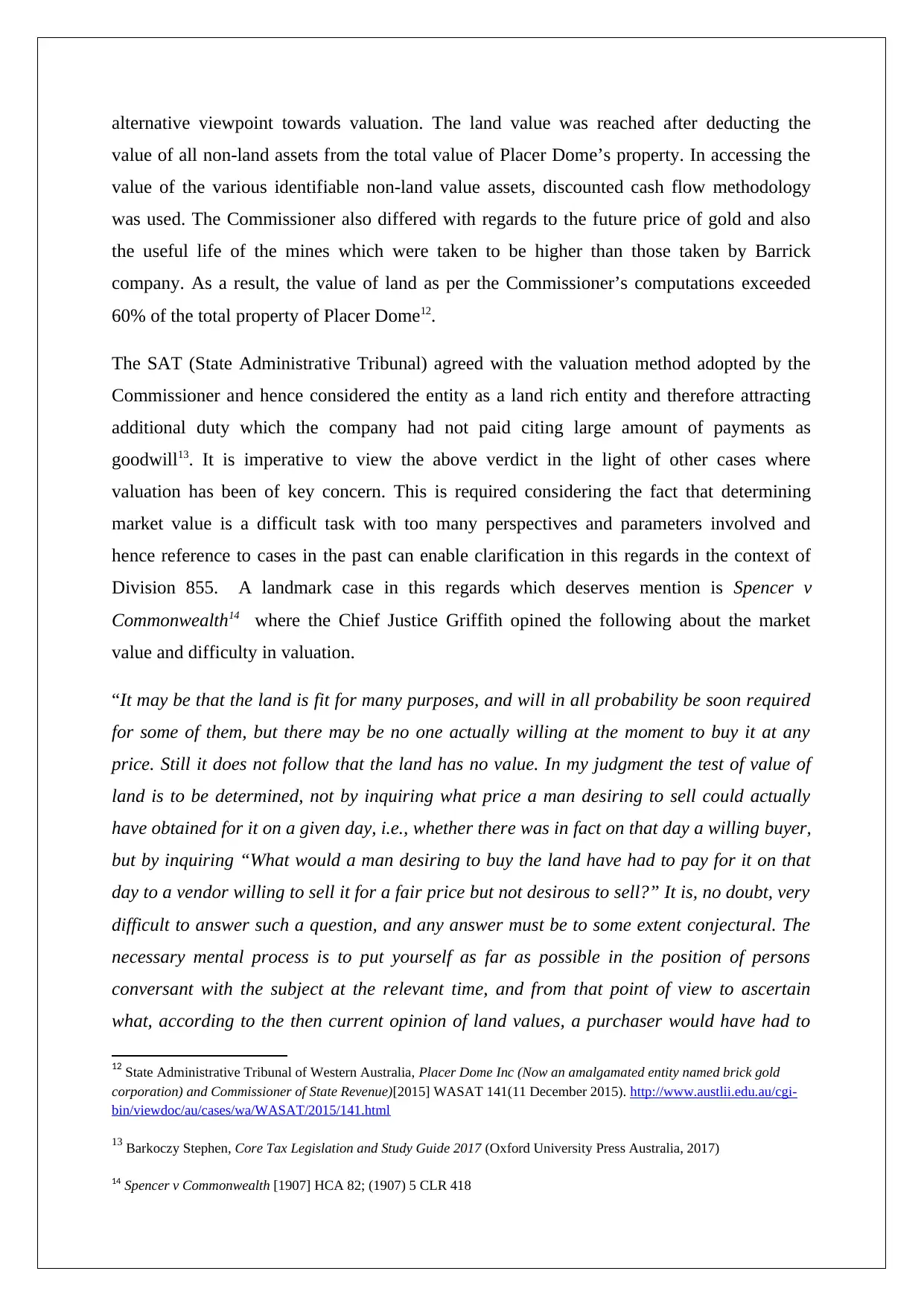
alternative viewpoint towards valuation. The land value was reached after deducting the
value of all non-land assets from the total value of Placer Dome’s property. In accessing the
value of the various identifiable non-land value assets, discounted cash flow methodology
was used. The Commissioner also differed with regards to the future price of gold and also
the useful life of the mines which were taken to be higher than those taken by Barrick
company. As a result, the value of land as per the Commissioner’s computations exceeded
60% of the total property of Placer Dome12.
The SAT (State Administrative Tribunal) agreed with the valuation method adopted by the
Commissioner and hence considered the entity as a land rich entity and therefore attracting
additional duty which the company had not paid citing large amount of payments as
goodwill13. It is imperative to view the above verdict in the light of other cases where
valuation has been of key concern. This is required considering the fact that determining
market value is a difficult task with too many perspectives and parameters involved and
hence reference to cases in the past can enable clarification in this regards in the context of
Division 855. A landmark case in this regards which deserves mention is Spencer v
Commonwealth14 where the Chief Justice Griffith opined the following about the market
value and difficulty in valuation.
“It may be that the land is fit for many purposes, and will in all probability be soon required
for some of them, but there may be no one actually willing at the moment to buy it at any
price. Still it does not follow that the land has no value. In my judgment the test of value of
land is to be determined, not by inquiring what price a man desiring to sell could actually
have obtained for it on a given day, i.e., whether there was in fact on that day a willing buyer,
but by inquiring “What would a man desiring to buy the land have had to pay for it on that
day to a vendor willing to sell it for a fair price but not desirous to sell?” It is, no doubt, very
difficult to answer such a question, and any answer must be to some extent conjectural. The
necessary mental process is to put yourself as far as possible in the position of persons
conversant with the subject at the relevant time, and from that point of view to ascertain
what, according to the then current opinion of land values, a purchaser would have had to
12 State Administrative Tribunal of Western Australia, Placer Dome Inc (Now an amalgamated entity named brick gold
corporation) and Commissioner of State Revenue)[2015] WASAT 141(11 December 2015). http://www.austlii.edu.au/cgi-
bin/viewdoc/au/cases/wa/WASAT/2015/141.html
13 Barkoczy Stephen, Core Tax Legislation and Study Guide 2017 (Oxford University Press Australia, 2017)
14 Spencer v Commonwealth [1907] HCA 82; (1907) 5 CLR 418
value of all non-land assets from the total value of Placer Dome’s property. In accessing the
value of the various identifiable non-land value assets, discounted cash flow methodology
was used. The Commissioner also differed with regards to the future price of gold and also
the useful life of the mines which were taken to be higher than those taken by Barrick
company. As a result, the value of land as per the Commissioner’s computations exceeded
60% of the total property of Placer Dome12.
The SAT (State Administrative Tribunal) agreed with the valuation method adopted by the
Commissioner and hence considered the entity as a land rich entity and therefore attracting
additional duty which the company had not paid citing large amount of payments as
goodwill13. It is imperative to view the above verdict in the light of other cases where
valuation has been of key concern. This is required considering the fact that determining
market value is a difficult task with too many perspectives and parameters involved and
hence reference to cases in the past can enable clarification in this regards in the context of
Division 855. A landmark case in this regards which deserves mention is Spencer v
Commonwealth14 where the Chief Justice Griffith opined the following about the market
value and difficulty in valuation.
“It may be that the land is fit for many purposes, and will in all probability be soon required
for some of them, but there may be no one actually willing at the moment to buy it at any
price. Still it does not follow that the land has no value. In my judgment the test of value of
land is to be determined, not by inquiring what price a man desiring to sell could actually
have obtained for it on a given day, i.e., whether there was in fact on that day a willing buyer,
but by inquiring “What would a man desiring to buy the land have had to pay for it on that
day to a vendor willing to sell it for a fair price but not desirous to sell?” It is, no doubt, very
difficult to answer such a question, and any answer must be to some extent conjectural. The
necessary mental process is to put yourself as far as possible in the position of persons
conversant with the subject at the relevant time, and from that point of view to ascertain
what, according to the then current opinion of land values, a purchaser would have had to
12 State Administrative Tribunal of Western Australia, Placer Dome Inc (Now an amalgamated entity named brick gold
corporation) and Commissioner of State Revenue)[2015] WASAT 141(11 December 2015). http://www.austlii.edu.au/cgi-
bin/viewdoc/au/cases/wa/WASAT/2015/141.html
13 Barkoczy Stephen, Core Tax Legislation and Study Guide 2017 (Oxford University Press Australia, 2017)
14 Spencer v Commonwealth [1907] HCA 82; (1907) 5 CLR 418
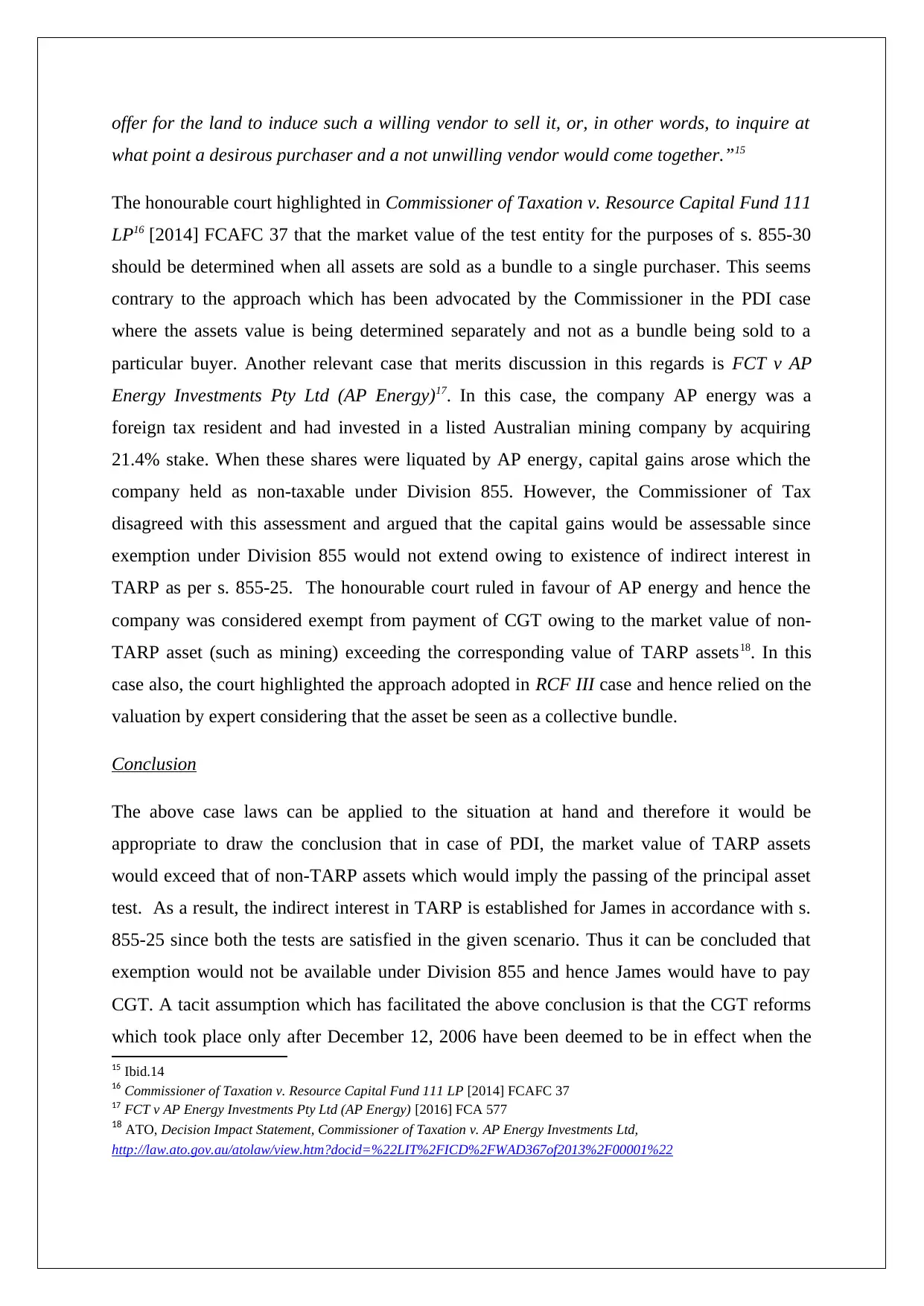
offer for the land to induce such a willing vendor to sell it, or, in other words, to inquire at
what point a desirous purchaser and a not unwilling vendor would come together.”15
The honourable court highlighted in Commissioner of Taxation v. Resource Capital Fund 111
LP16 [2014] FCAFC 37 that the market value of the test entity for the purposes of s. 855-30
should be determined when all assets are sold as a bundle to a single purchaser. This seems
contrary to the approach which has been advocated by the Commissioner in the PDI case
where the assets value is being determined separately and not as a bundle being sold to a
particular buyer. Another relevant case that merits discussion in this regards is FCT v AP
Energy Investments Pty Ltd (AP Energy)17. In this case, the company AP energy was a
foreign tax resident and had invested in a listed Australian mining company by acquiring
21.4% stake. When these shares were liquated by AP energy, capital gains arose which the
company held as non-taxable under Division 855. However, the Commissioner of Tax
disagreed with this assessment and argued that the capital gains would be assessable since
exemption under Division 855 would not extend owing to existence of indirect interest in
TARP as per s. 855-25. The honourable court ruled in favour of AP energy and hence the
company was considered exempt from payment of CGT owing to the market value of non-
TARP asset (such as mining) exceeding the corresponding value of TARP assets18. In this
case also, the court highlighted the approach adopted in RCF III case and hence relied on the
valuation by expert considering that the asset be seen as a collective bundle.
Conclusion
The above case laws can be applied to the situation at hand and therefore it would be
appropriate to draw the conclusion that in case of PDI, the market value of TARP assets
would exceed that of non-TARP assets which would imply the passing of the principal asset
test. As a result, the indirect interest in TARP is established for James in accordance with s.
855-25 since both the tests are satisfied in the given scenario. Thus it can be concluded that
exemption would not be available under Division 855 and hence James would have to pay
CGT. A tacit assumption which has facilitated the above conclusion is that the CGT reforms
which took place only after December 12, 2006 have been deemed to be in effect when the
15 Ibid.14
16 Commissioner of Taxation v. Resource Capital Fund 111 LP [2014] FCAFC 37
17 FCT v AP Energy Investments Pty Ltd (AP Energy) [2016] FCA 577
18 ATO, Decision Impact Statement, Commissioner of Taxation v. AP Energy Investments Ltd,
http://law.ato.gov.au/atolaw/view.htm?docid=%22LIT%2FICD%2FWAD367of2013%2F00001%22
what point a desirous purchaser and a not unwilling vendor would come together.”15
The honourable court highlighted in Commissioner of Taxation v. Resource Capital Fund 111
LP16 [2014] FCAFC 37 that the market value of the test entity for the purposes of s. 855-30
should be determined when all assets are sold as a bundle to a single purchaser. This seems
contrary to the approach which has been advocated by the Commissioner in the PDI case
where the assets value is being determined separately and not as a bundle being sold to a
particular buyer. Another relevant case that merits discussion in this regards is FCT v AP
Energy Investments Pty Ltd (AP Energy)17. In this case, the company AP energy was a
foreign tax resident and had invested in a listed Australian mining company by acquiring
21.4% stake. When these shares were liquated by AP energy, capital gains arose which the
company held as non-taxable under Division 855. However, the Commissioner of Tax
disagreed with this assessment and argued that the capital gains would be assessable since
exemption under Division 855 would not extend owing to existence of indirect interest in
TARP as per s. 855-25. The honourable court ruled in favour of AP energy and hence the
company was considered exempt from payment of CGT owing to the market value of non-
TARP asset (such as mining) exceeding the corresponding value of TARP assets18. In this
case also, the court highlighted the approach adopted in RCF III case and hence relied on the
valuation by expert considering that the asset be seen as a collective bundle.
Conclusion
The above case laws can be applied to the situation at hand and therefore it would be
appropriate to draw the conclusion that in case of PDI, the market value of TARP assets
would exceed that of non-TARP assets which would imply the passing of the principal asset
test. As a result, the indirect interest in TARP is established for James in accordance with s.
855-25 since both the tests are satisfied in the given scenario. Thus it can be concluded that
exemption would not be available under Division 855 and hence James would have to pay
CGT. A tacit assumption which has facilitated the above conclusion is that the CGT reforms
which took place only after December 12, 2006 have been deemed to be in effect when the
15 Ibid.14
16 Commissioner of Taxation v. Resource Capital Fund 111 LP [2014] FCAFC 37
17 FCT v AP Energy Investments Pty Ltd (AP Energy) [2016] FCA 577
18 ATO, Decision Impact Statement, Commissioner of Taxation v. AP Energy Investments Ltd,
http://law.ato.gov.au/atolaw/view.htm?docid=%22LIT%2FICD%2FWAD367of2013%2F00001%22
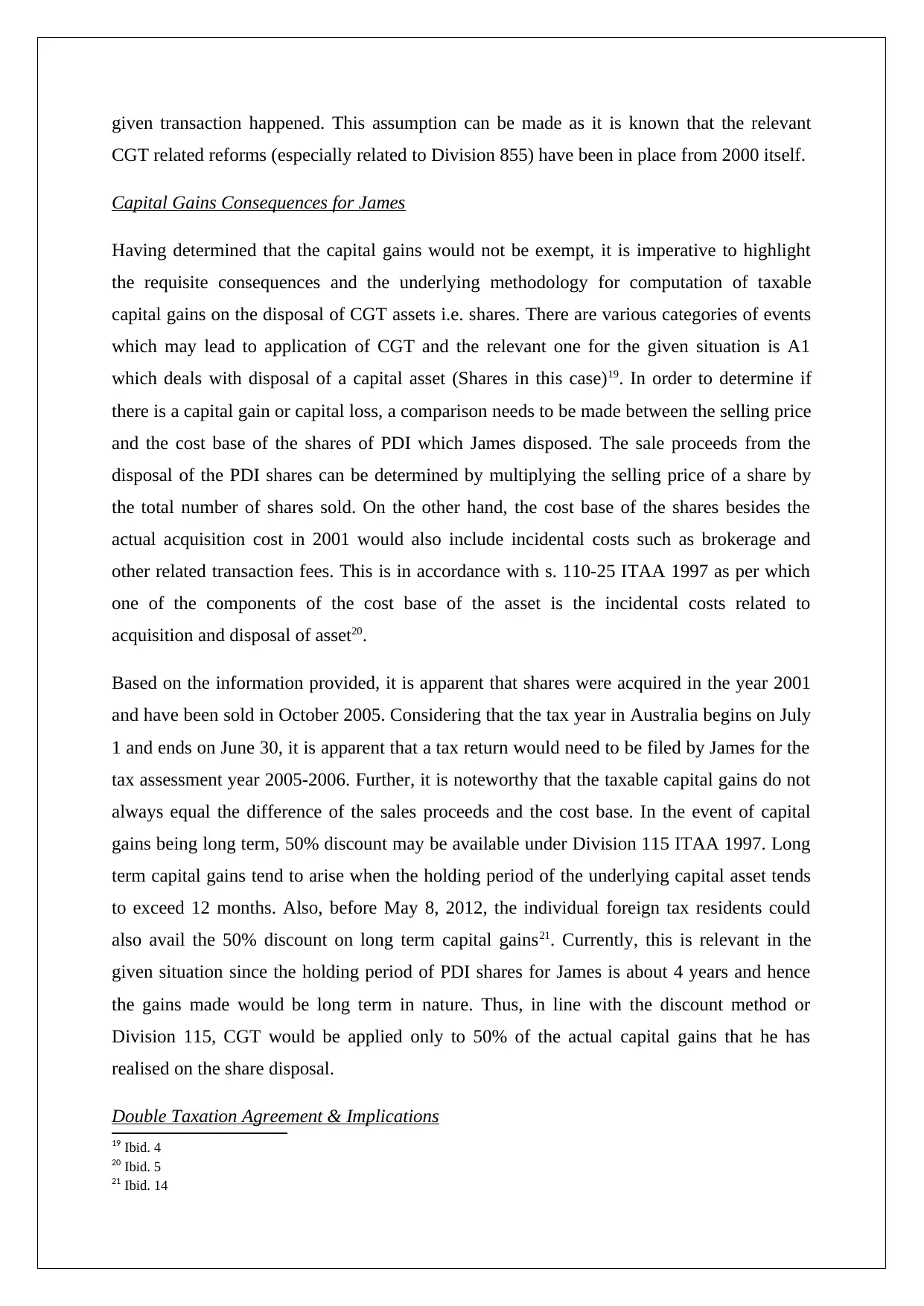
given transaction happened. This assumption can be made as it is known that the relevant
CGT related reforms (especially related to Division 855) have been in place from 2000 itself.
Capital Gains Consequences for James
Having determined that the capital gains would not be exempt, it is imperative to highlight
the requisite consequences and the underlying methodology for computation of taxable
capital gains on the disposal of CGT assets i.e. shares. There are various categories of events
which may lead to application of CGT and the relevant one for the given situation is A1
which deals with disposal of a capital asset (Shares in this case)19. In order to determine if
there is a capital gain or capital loss, a comparison needs to be made between the selling price
and the cost base of the shares of PDI which James disposed. The sale proceeds from the
disposal of the PDI shares can be determined by multiplying the selling price of a share by
the total number of shares sold. On the other hand, the cost base of the shares besides the
actual acquisition cost in 2001 would also include incidental costs such as brokerage and
other related transaction fees. This is in accordance with s. 110-25 ITAA 1997 as per which
one of the components of the cost base of the asset is the incidental costs related to
acquisition and disposal of asset20.
Based on the information provided, it is apparent that shares were acquired in the year 2001
and have been sold in October 2005. Considering that the tax year in Australia begins on July
1 and ends on June 30, it is apparent that a tax return would need to be filed by James for the
tax assessment year 2005-2006. Further, it is noteworthy that the taxable capital gains do not
always equal the difference of the sales proceeds and the cost base. In the event of capital
gains being long term, 50% discount may be available under Division 115 ITAA 1997. Long
term capital gains tend to arise when the holding period of the underlying capital asset tends
to exceed 12 months. Also, before May 8, 2012, the individual foreign tax residents could
also avail the 50% discount on long term capital gains21. Currently, this is relevant in the
given situation since the holding period of PDI shares for James is about 4 years and hence
the gains made would be long term in nature. Thus, in line with the discount method or
Division 115, CGT would be applied only to 50% of the actual capital gains that he has
realised on the share disposal.
Double Taxation Agreement & Implications
19 Ibid. 4
20 Ibid. 5
21 Ibid. 14
CGT related reforms (especially related to Division 855) have been in place from 2000 itself.
Capital Gains Consequences for James
Having determined that the capital gains would not be exempt, it is imperative to highlight
the requisite consequences and the underlying methodology for computation of taxable
capital gains on the disposal of CGT assets i.e. shares. There are various categories of events
which may lead to application of CGT and the relevant one for the given situation is A1
which deals with disposal of a capital asset (Shares in this case)19. In order to determine if
there is a capital gain or capital loss, a comparison needs to be made between the selling price
and the cost base of the shares of PDI which James disposed. The sale proceeds from the
disposal of the PDI shares can be determined by multiplying the selling price of a share by
the total number of shares sold. On the other hand, the cost base of the shares besides the
actual acquisition cost in 2001 would also include incidental costs such as brokerage and
other related transaction fees. This is in accordance with s. 110-25 ITAA 1997 as per which
one of the components of the cost base of the asset is the incidental costs related to
acquisition and disposal of asset20.
Based on the information provided, it is apparent that shares were acquired in the year 2001
and have been sold in October 2005. Considering that the tax year in Australia begins on July
1 and ends on June 30, it is apparent that a tax return would need to be filed by James for the
tax assessment year 2005-2006. Further, it is noteworthy that the taxable capital gains do not
always equal the difference of the sales proceeds and the cost base. In the event of capital
gains being long term, 50% discount may be available under Division 115 ITAA 1997. Long
term capital gains tend to arise when the holding period of the underlying capital asset tends
to exceed 12 months. Also, before May 8, 2012, the individual foreign tax residents could
also avail the 50% discount on long term capital gains21. Currently, this is relevant in the
given situation since the holding period of PDI shares for James is about 4 years and hence
the gains made would be long term in nature. Thus, in line with the discount method or
Division 115, CGT would be applied only to 50% of the actual capital gains that he has
realised on the share disposal.
Double Taxation Agreement & Implications
19 Ibid. 4
20 Ibid. 5
21 Ibid. 14
Paraphrase This Document
Need a fresh take? Get an instant paraphrase of this document with our AI Paraphraser
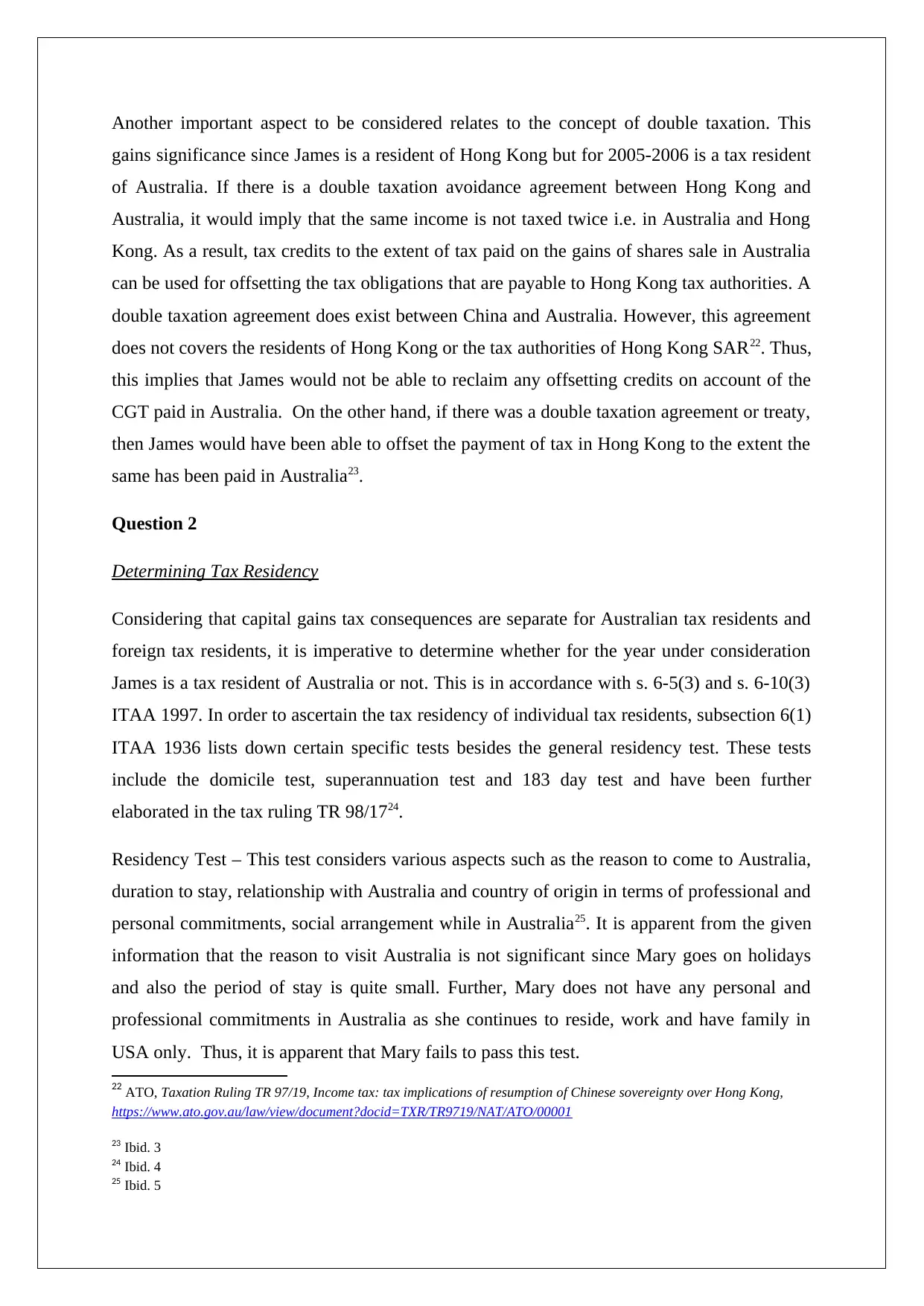
Another important aspect to be considered relates to the concept of double taxation. This
gains significance since James is a resident of Hong Kong but for 2005-2006 is a tax resident
of Australia. If there is a double taxation avoidance agreement between Hong Kong and
Australia, it would imply that the same income is not taxed twice i.e. in Australia and Hong
Kong. As a result, tax credits to the extent of tax paid on the gains of shares sale in Australia
can be used for offsetting the tax obligations that are payable to Hong Kong tax authorities. A
double taxation agreement does exist between China and Australia. However, this agreement
does not covers the residents of Hong Kong or the tax authorities of Hong Kong SAR22. Thus,
this implies that James would not be able to reclaim any offsetting credits on account of the
CGT paid in Australia. On the other hand, if there was a double taxation agreement or treaty,
then James would have been able to offset the payment of tax in Hong Kong to the extent the
same has been paid in Australia23.
Question 2
Determining Tax Residency
Considering that capital gains tax consequences are separate for Australian tax residents and
foreign tax residents, it is imperative to determine whether for the year under consideration
James is a tax resident of Australia or not. This is in accordance with s. 6-5(3) and s. 6-10(3)
ITAA 1997. In order to ascertain the tax residency of individual tax residents, subsection 6(1)
ITAA 1936 lists down certain specific tests besides the general residency test. These tests
include the domicile test, superannuation test and 183 day test and have been further
elaborated in the tax ruling TR 98/1724.
Residency Test – This test considers various aspects such as the reason to come to Australia,
duration to stay, relationship with Australia and country of origin in terms of professional and
personal commitments, social arrangement while in Australia25. It is apparent from the given
information that the reason to visit Australia is not significant since Mary goes on holidays
and also the period of stay is quite small. Further, Mary does not have any personal and
professional commitments in Australia as she continues to reside, work and have family in
USA only. Thus, it is apparent that Mary fails to pass this test.
22 ATO, Taxation Ruling TR 97/19, Income tax: tax implications of resumption of Chinese sovereignty over Hong Kong,
https://www.ato.gov.au/law/view/document?docid=TXR/TR9719/NAT/ATO/00001
23 Ibid. 3
24 Ibid. 4
25 Ibid. 5
gains significance since James is a resident of Hong Kong but for 2005-2006 is a tax resident
of Australia. If there is a double taxation avoidance agreement between Hong Kong and
Australia, it would imply that the same income is not taxed twice i.e. in Australia and Hong
Kong. As a result, tax credits to the extent of tax paid on the gains of shares sale in Australia
can be used for offsetting the tax obligations that are payable to Hong Kong tax authorities. A
double taxation agreement does exist between China and Australia. However, this agreement
does not covers the residents of Hong Kong or the tax authorities of Hong Kong SAR22. Thus,
this implies that James would not be able to reclaim any offsetting credits on account of the
CGT paid in Australia. On the other hand, if there was a double taxation agreement or treaty,
then James would have been able to offset the payment of tax in Hong Kong to the extent the
same has been paid in Australia23.
Question 2
Determining Tax Residency
Considering that capital gains tax consequences are separate for Australian tax residents and
foreign tax residents, it is imperative to determine whether for the year under consideration
James is a tax resident of Australia or not. This is in accordance with s. 6-5(3) and s. 6-10(3)
ITAA 1997. In order to ascertain the tax residency of individual tax residents, subsection 6(1)
ITAA 1936 lists down certain specific tests besides the general residency test. These tests
include the domicile test, superannuation test and 183 day test and have been further
elaborated in the tax ruling TR 98/1724.
Residency Test – This test considers various aspects such as the reason to come to Australia,
duration to stay, relationship with Australia and country of origin in terms of professional and
personal commitments, social arrangement while in Australia25. It is apparent from the given
information that the reason to visit Australia is not significant since Mary goes on holidays
and also the period of stay is quite small. Further, Mary does not have any personal and
professional commitments in Australia as she continues to reside, work and have family in
USA only. Thus, it is apparent that Mary fails to pass this test.
22 ATO, Taxation Ruling TR 97/19, Income tax: tax implications of resumption of Chinese sovereignty over Hong Kong,
https://www.ato.gov.au/law/view/document?docid=TXR/TR9719/NAT/ATO/00001
23 Ibid. 3
24 Ibid. 4
25 Ibid. 5

Domicile Test – The requirement of the domicile test is that the underlying taxpayer should
be a Australian domicile holder as per Domicile Act 198126. This is not the case with regards
to Mary who is a USA domicile and hence fails the test.
Superannuation Test – One of the requirements of superannuation test is that the underlying
taxpayer for the assessment year must be registered for the public superannuation scheme and
must have contributed to the same27. Clearly, Mary does not satisfy the same.
183 days test – One of the main requirements of this residency test is that the underlying
taxpayer should have been physically present in Australia for atleast 183 days during the tax
assessment year under consideration28. Based on the given information, it is apparent that
Mary spends only three weeks in Australia every year and hence fails to satisfy the
requirements of this test.
On the basis of the above discussion, it may be appropriate to conclude that Mary would be
considered as a foreign tax resident.
CGT Implications for Mary
Based on the given situation, it is apparent that Mary acquired a 2% stake in PDI which was
liquidated in tax assessment year 2005-2006.
Division 855 ITAA 1997 can provide relief to foreign tax residents against paying taxes in
Australia on account of capital gains made. As per s. 885-1, the capital gains made by a
foreign tax resident can be disregarded provided that the underlying CGT asset does not
represent an interest (direct or indirect) in the Australian real property29. In accordance with
Section 855-20, a given CGT asset would be classified as TARP if any of the following two
conditions are satisfied30.
The asset comprises of a real property that is located in Australia and also constitutes
lease of Australia based land
Right with regards to quarrying, mining or prospecting provided that the underlying
mineral, quarry material or petroleum should be located in Australia only
26 Ibid. 13
27 Ibid. 4
28 Ibid. 2
29 Ibid. 6
30 Ibid. 8
be a Australian domicile holder as per Domicile Act 198126. This is not the case with regards
to Mary who is a USA domicile and hence fails the test.
Superannuation Test – One of the requirements of superannuation test is that the underlying
taxpayer for the assessment year must be registered for the public superannuation scheme and
must have contributed to the same27. Clearly, Mary does not satisfy the same.
183 days test – One of the main requirements of this residency test is that the underlying
taxpayer should have been physically present in Australia for atleast 183 days during the tax
assessment year under consideration28. Based on the given information, it is apparent that
Mary spends only three weeks in Australia every year and hence fails to satisfy the
requirements of this test.
On the basis of the above discussion, it may be appropriate to conclude that Mary would be
considered as a foreign tax resident.
CGT Implications for Mary
Based on the given situation, it is apparent that Mary acquired a 2% stake in PDI which was
liquidated in tax assessment year 2005-2006.
Division 855 ITAA 1997 can provide relief to foreign tax residents against paying taxes in
Australia on account of capital gains made. As per s. 885-1, the capital gains made by a
foreign tax resident can be disregarded provided that the underlying CGT asset does not
represent an interest (direct or indirect) in the Australian real property29. In accordance with
Section 855-20, a given CGT asset would be classified as TARP if any of the following two
conditions are satisfied30.
The asset comprises of a real property that is located in Australia and also constitutes
lease of Australia based land
Right with regards to quarrying, mining or prospecting provided that the underlying
mineral, quarry material or petroleum should be located in Australia only
26 Ibid. 13
27 Ibid. 4
28 Ibid. 2
29 Ibid. 6
30 Ibid. 8
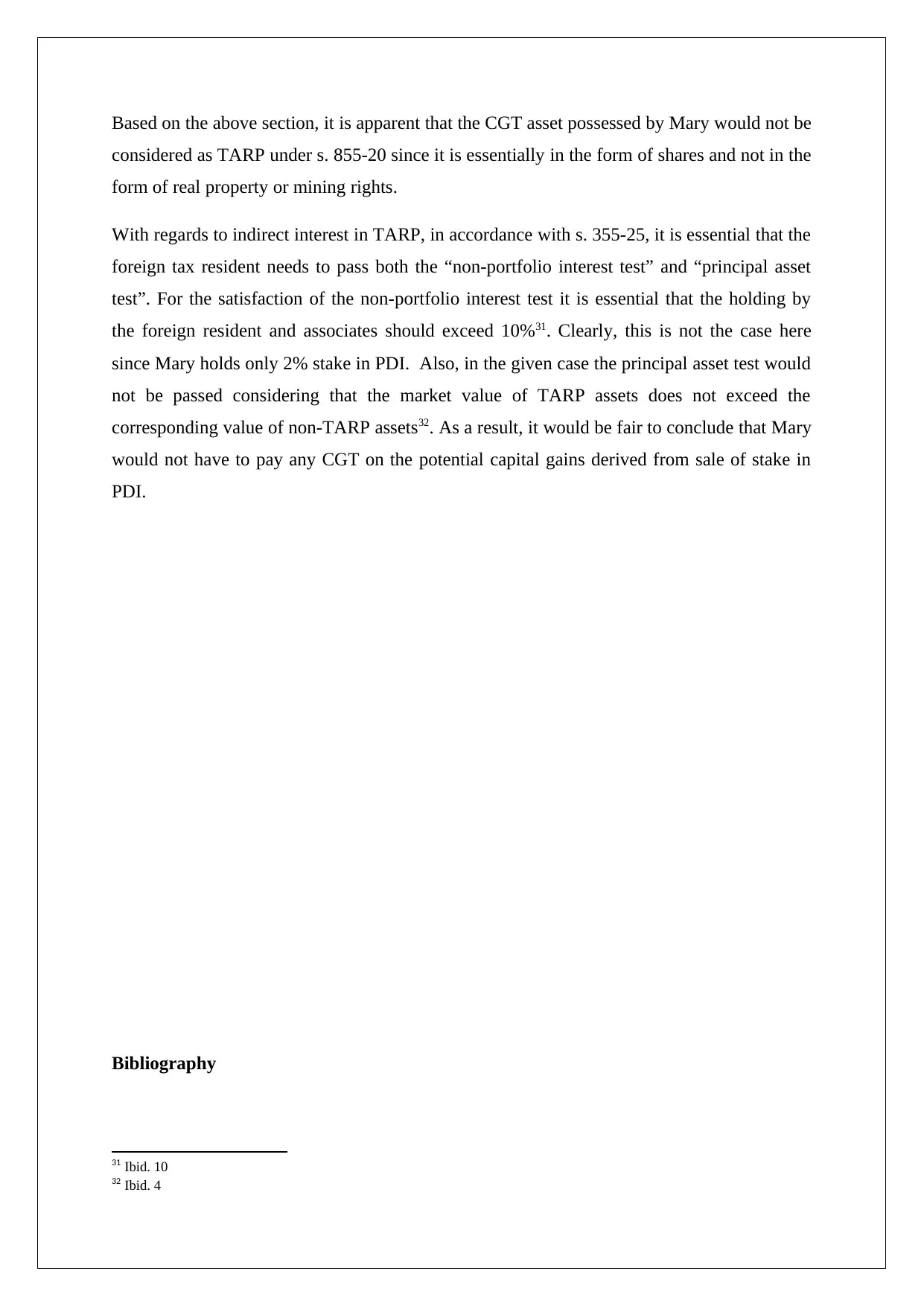
Based on the above section, it is apparent that the CGT asset possessed by Mary would not be
considered as TARP under s. 855-20 since it is essentially in the form of shares and not in the
form of real property or mining rights.
With regards to indirect interest in TARP, in accordance with s. 355-25, it is essential that the
foreign tax resident needs to pass both the “non-portfolio interest test” and “principal asset
test”. For the satisfaction of the non-portfolio interest test it is essential that the holding by
the foreign resident and associates should exceed 10%31. Clearly, this is not the case here
since Mary holds only 2% stake in PDI. Also, in the given case the principal asset test would
not be passed considering that the market value of TARP assets does not exceed the
corresponding value of non-TARP assets32. As a result, it would be fair to conclude that Mary
would not have to pay any CGT on the potential capital gains derived from sale of stake in
PDI.
Bibliography
31 Ibid. 10
32 Ibid. 4
considered as TARP under s. 855-20 since it is essentially in the form of shares and not in the
form of real property or mining rights.
With regards to indirect interest in TARP, in accordance with s. 355-25, it is essential that the
foreign tax resident needs to pass both the “non-portfolio interest test” and “principal asset
test”. For the satisfaction of the non-portfolio interest test it is essential that the holding by
the foreign resident and associates should exceed 10%31. Clearly, this is not the case here
since Mary holds only 2% stake in PDI. Also, in the given case the principal asset test would
not be passed considering that the market value of TARP assets does not exceed the
corresponding value of non-TARP assets32. As a result, it would be fair to conclude that Mary
would not have to pay any CGT on the potential capital gains derived from sale of stake in
PDI.
Bibliography
31 Ibid. 10
32 Ibid. 4
Secure Best Marks with AI Grader
Need help grading? Try our AI Grader for instant feedback on your assignments.

ATO, Decision Impact Statement, Commissioner of Taxation v. AP Energy Investments Ltd,
http://law.ato.gov.au/atolaw/view.htm?docid=%22LIT%2FICD
%2FWAD367of2013%2F00001%22
ATO, Taxation Ruling TR 97/19, Income tax: tax implications of resumption of Chinese
sovereignty over Hong Kong,
https://www.ato.gov.au/law/view/document?docid=TXR/TR9719/NAT/ATO/00001
Barkoczy Stephen, Core Tax Legislation and Study Guide 2017 (Oxford University Press
Australia, 2017)
Barkoczy, Stephen, et al, Australian Taxation Law 2017 (Oxford University Press Australia.,
27thed, 2017)
Commonwealth Consolidated Acts, Income Tax Assessment Act 1997- SECT
855.20,http://www5.austlii.edu.au/au/legis/cth/consol_act/itaa1997240/s855.20.html
Commonwealth Consolidated Acts, Income Tax Assessment Act 1997- SECT
855.25,http://www5.austlii.edu.au/au/legis/cth/consol_act/itaa1997240/s855.25.html
Commonwealth Consolidated Acts, Income Tax Assessment Act 1997- SECT
855.30,http://www5.austlii.edu.au/au/legis/cth/consol_act/itaa1997240/s855.30.html
Commonwealth Consolidated Acts, Income Tax Assessment Act 1997- SECT 855.1,
http://www5.austlii.edu.au/au/legis/cth/consol_act/itaa1997240/s855.1.html
Krever Richard, Australian Taxation Law Cases 2017 (THOMSON LAWBOOK Company,
2017)
Reuters, Australian Tax Legislation (THOMSON REUTERS, 2017)
State Administrative Tribunal of Western Australia, Placer Dome Inc (Now an amalgamated
entity named brick gold corporation) and Commissioner of State Revenue)[2015] WASAT
141(11 December 2015).
http://www.austlii.edu.au/cgi-bin/viewdoc/au/cases/wa/WASAT/2015/141.html
http://law.ato.gov.au/atolaw/view.htm?docid=%22LIT%2FICD
%2FWAD367of2013%2F00001%22
ATO, Taxation Ruling TR 97/19, Income tax: tax implications of resumption of Chinese
sovereignty over Hong Kong,
https://www.ato.gov.au/law/view/document?docid=TXR/TR9719/NAT/ATO/00001
Barkoczy Stephen, Core Tax Legislation and Study Guide 2017 (Oxford University Press
Australia, 2017)
Barkoczy, Stephen, et al, Australian Taxation Law 2017 (Oxford University Press Australia.,
27thed, 2017)
Commonwealth Consolidated Acts, Income Tax Assessment Act 1997- SECT
855.20,http://www5.austlii.edu.au/au/legis/cth/consol_act/itaa1997240/s855.20.html
Commonwealth Consolidated Acts, Income Tax Assessment Act 1997- SECT
855.25,http://www5.austlii.edu.au/au/legis/cth/consol_act/itaa1997240/s855.25.html
Commonwealth Consolidated Acts, Income Tax Assessment Act 1997- SECT
855.30,http://www5.austlii.edu.au/au/legis/cth/consol_act/itaa1997240/s855.30.html
Commonwealth Consolidated Acts, Income Tax Assessment Act 1997- SECT 855.1,
http://www5.austlii.edu.au/au/legis/cth/consol_act/itaa1997240/s855.1.html
Krever Richard, Australian Taxation Law Cases 2017 (THOMSON LAWBOOK Company,
2017)
Reuters, Australian Tax Legislation (THOMSON REUTERS, 2017)
State Administrative Tribunal of Western Australia, Placer Dome Inc (Now an amalgamated
entity named brick gold corporation) and Commissioner of State Revenue)[2015] WASAT
141(11 December 2015).
http://www.austlii.edu.au/cgi-bin/viewdoc/au/cases/wa/WASAT/2015/141.html
1 out of 11
Related Documents
Your All-in-One AI-Powered Toolkit for Academic Success.
+13062052269
info@desklib.com
Available 24*7 on WhatsApp / Email
![[object Object]](/_next/static/media/star-bottom.7253800d.svg)
Unlock your academic potential
© 2024 | Zucol Services PVT LTD | All rights reserved.



